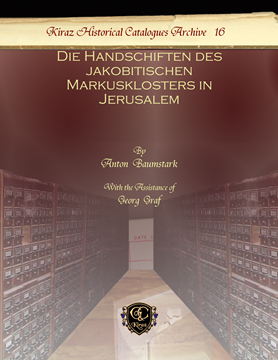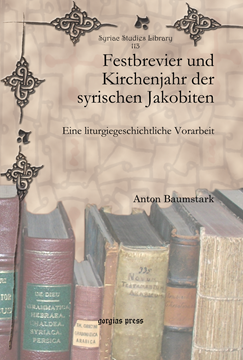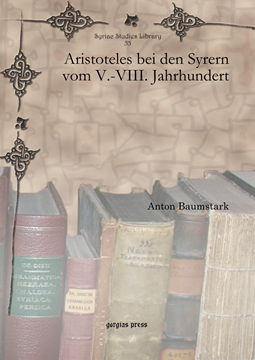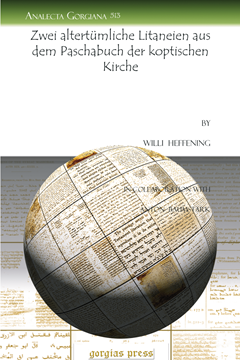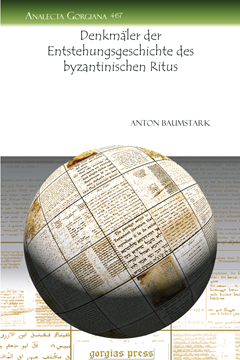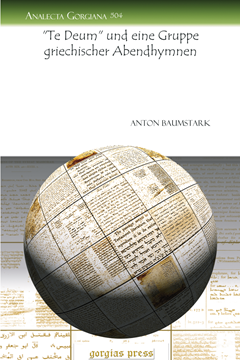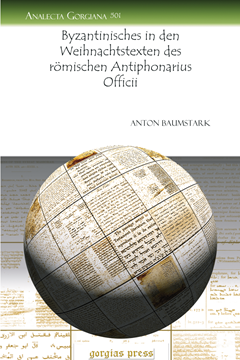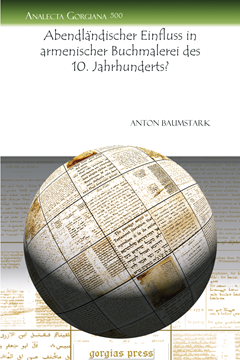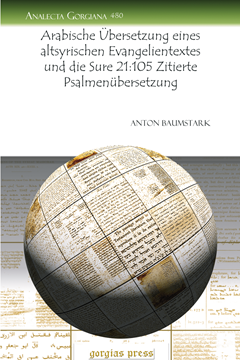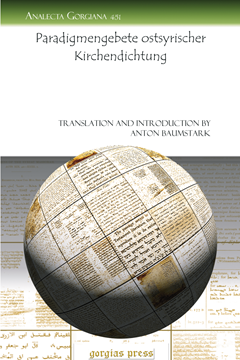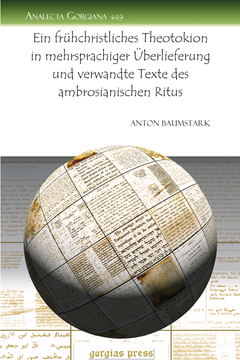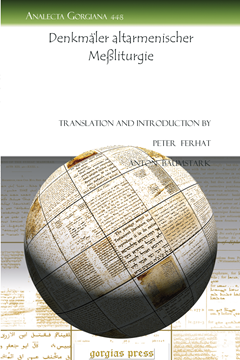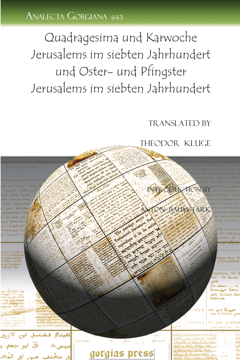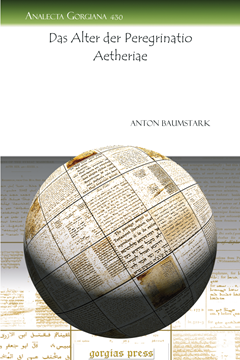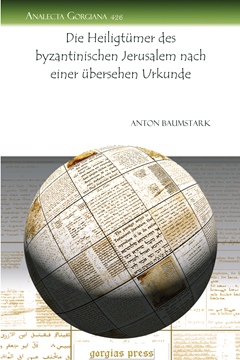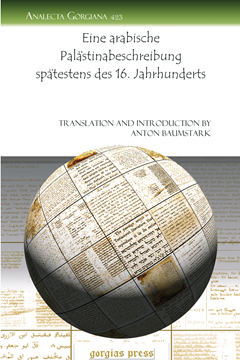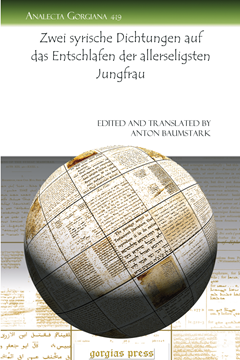Anton Baumstark
Syrisch-arabische Biographieen des Aristotles. Syrische Commentare zur Eisagoge des Porphyrios
Translation and Introduction by Anton Baumstark
Series: Syriac Studies Library 196
ISBN: 978-1-61143-403-3
The surviving versions of the Syriac translation of Ptolemy's life of Aristotle (which contains Aristotle's will), and the Syriac commentaries on Porphyry's Isagoge; the only printed edition, with extensive introduction.
$167.00 (USD) $100.20 (USD)
Die Handschiften des jakobitischen Markusklosters in Jerusalem
By Anton Baumstark; With the Assistance of Georg Graf
Series: Kiraz Historical Catalogues Archive 16
ISBN: 978-1-61143-024-0
This work is a catalogue of 38 Arabic and Syriac manuscripts found in the Syrian Orthodox Monastery of St. Mark in Jerusalem; contains liturgical and literary works.
$151.00 (USD) $90.60 (USD)
Festbrevier und Kirchenjahr der syrischen Jakobiten
Eine liturgiegeschichtliche Vorarbeit
Series: Syriac Studies Library 113
ISBN: 978-1-61719-235-7
This essential volume on the Syrian Orthodox liturgy (Fenquitho) by an eminent liturgist covers both the development of the liturgy itself and the structure of the church year.
$192.00 (USD) $115.20 (USD)
Aristoteles bei den Syrern vom V.-VIII. Jahrhundert
Series: Syriac Studies Library 53
ISBN: 978-1-60724-936-8
In this volume, Baumstark deals with the transmission of Aristotelian philosophy into Syriac and Arabic. Syriac texts with German translations are included, alongside a detailed study of their textual interrelationships.
$172.00 (USD) $103.20 (USD)
Zwei altertümliche Litaneien aus dem Paschabuch der koptischen Kirche
By Willi Heffening; In Collaboration With Anton Baumstark
Series: Analecta Gorgiana 513
ISBN: 978-1-60724-992-4
Willi Heffening publishes a German translation of two litanies that are preserved only in a Paschal book from the Coptic Church. Heffening also includes an introduction and supplements the translation with critical notes.
$37.00 (USD) $22.20 (USD)
Erbe christlicher Antike im Bildschmuck eines arabischen Evangelienbuches des 14. Jarhunderts
Series: Analecta Gorgiana 510
ISBN: 978-1-60724-989-4
In the present article, Anton Baumstark describes the decorative illustrations found in an Arabic gospel text of the fourteenth century and concludes that they represent antique artistic features that were preserved only in the Oriental manuscript tradition.
$39.00 (USD) $23.40 (USD)
Ein "Evangelium"-Zitat der manichäischen Kephalaia
Series: Analecta Gorgiana 508
ISBN: 978-1-60724-987-0
Anton Baumstark compares the text of a Gospel citation found in a Coptic Manichaean Kephalaia with other versions of the text in order to demonstrate that it was influenced by the Diatessaron tradition.
$36.00 (USD) $21.60 (USD)
Das Problem des christlich-palästinensischen Pentateuchtextes
Series: Analecta Gorgiana 507
ISBN: 978-1-60724-986-3
Anton Baumstark discusses the various, complex problems inherent in any attempt to determine the influences from other translation traditions on the form of the Christian-Palestinian text of the Pentateuch.
$36.00 (USD) $21.60 (USD)
Denkmäler der Entstehungsgeschichte des byzantinischen Ritus
Series: Analecta Gorgiana 467
ISBN: 978-1-60724-922-1
Anton Baumstark surveys key developments in the Byzantine liturgical rite and attempts to view these developments within the historical circumstances that likely affected or caused them.
$38.00 (USD) $22.80 (USD)
"Te Deum" und eine Gruppe griechischer Abendhymnen
Series: Analecta Gorgiana 504
ISBN: 978-1-60724-983-2
Anton Baumstark compares selections from the Latin Te Deum hymns with eastern Eucharistic prayers in order to find evidence of eastern influence on the western liturgical tradition.
$36.00 (USD) $21.60 (USD)
Byzantinisches in den Weihnachtstexten des römischen Antiphonarius Officii
Series: Analecta Gorgiana 501
ISBN: 978-1-60724-980-1
In the present essay, Anton Baumstark surveys several Christmas texts from the Roman Antiphonarius Officii in an attempt to find evidence of Byzantine influence. Baumstark focuses the comparison on poetic texts in the Byzantine tradition.
$36.00 (USD) $21.60 (USD)
Abendländischer Einfluss in armenischer Buchmalerei des 10. Jahrhunderts?
Series: Analecta Gorgiana 500
ISBN: 978-1-60724-979-5
In the present essay, Anton Baumstark responds to E. Weigand’s argument for a Western influence on the artwork found in tenth century illustrated Armenian manuscripts by demonstrating that the artistic influences could have come from the Eastern tradition as well.
$37.00 (USD) $22.20 (USD)
Orientalisches in altspanischer Liturgie
Series: Analecta Gorgiana 482
ISBN: 978-1-60724-950-4
Anton Baumstark compares elements of the “old-Spanish” or Mozarabic liturgy with eastern liturgies in order to demonstrate an “oriental” influence.
$39.00 (USD) $23.40 (USD)
105 Zitierte Psalmenübersetzung
Series: Analecta Gorgiana 480
ISBN: 978-1-60724-948-1
The Syriac tradition played an important role in shaping pre- and early Islamic concepts of Christianity. In this article, Anton Baumstark argues that a few Arabic citations of the Bible reflect reliance on Old Syriac translations rather than the Peshitta.
$36.00 (USD) $21.60 (USD)
Paradigmengebete ostsyrischer Kirchendichtung
Translation and Introduction by Anton Baumstark
Series: Analecta Gorgiana 451
ISBN: 978-1-60724-885-9
Anton Baumstark surveys the possible literary sources for liturtgical hymn prayers of the Eastern Syriac tradition and also provides a Latin translation of nineteen such prayers found in Bedjan’s Chaldean Breviary.
$38.00 (USD) $22.80 (USD)
Ein frühchristliches Theotokion in mehrsprachiger Überlieferung und verwandte Texte des ambrosianisc
Series: Analecta Gorgiana 449
ISBN: 978-1-60724-883-5
Anton Baumstark compares the Greek text of a Theotokion preserved in a sixth-century manuscript to comparable texts from the Oriental Christian traditions and the Western Ambrosian Rite.
$36.00 (USD) $21.60 (USD)
Denkmäler altarmenischer Meßliturgie
Translation and Introduction by Peter Ferhat & Anton Baumstark
Series: Analecta Gorgiana 448
ISBN: 978-1-60724-882-8
Joseph Catergian’s Die Liturgien bei den Armeniern was significant for liturgical studies in the Armenian tradition, but it lacked translations of the texts. The present publication includes translations by Peter Ferhart, Anton Baumstark, and Adolf Rücker.
$47.00 (USD) $28.20 (USD)
Quadragesima und Karwoche Jerusalems im siebten Jahrhundert und Oster- und Pfingster Jerusalems im s
Translated by Theodor Kluge; Introduction by Anton Baumstark
Series: Analecta Gorgiana 443
ISBN: 978-1-60724-851-4
Theodor Kluge publishes a German translation of two Eastern Christian liturgical texts for use in Holy Week, Easter and Pentecost. Anton Baumstark adds notations to the translation and includes an introduction to each text.
$41.00 (USD) $24.60 (USD)
Das Alter der Peregrinatio Aetheriae
Series: Analecta Gorgiana 430
ISBN: 978-1-60724-736-4
Anton Baumstark discusses the critical issues in the dating of the text of the Peregrinatio of Egeria. After comparing the account with other texts, Baumstark concludes in favor of the traditional fourth-century date and provides needed support for this conclusion.
$41.00 (USD) $24.60 (USD)
Ein byzantinischer Buchschmuck des Praxapostolos und seine syro-palästinensische Vorlage
Series: Analecta Gorgiana 427
ISBN: 978-1-60724-733-3
Illustrations were common in manuscripts of the Gospels, but far less common for the Acts and Epistles. Anton Baumstark describes the images found in one manuscript that does include illustrations for these documents and compares them with the Eastern tradition.
$36.00 (USD) $21.60 (USD)
Die Heiligtümer des byzantinischen Jerusalem nach einer übersehen Urkunde
Series: Analecta Gorgiana 426
ISBN: 978-1-60724-732-6
Anton Baumstark compares the description of various holy sites in Jerusalem from the Byzantine age in a neglected source—a tenth-century Typikon of Anastasis—with the descriptions found in other ancient texts.
$44.00 (USD) $26.40 (USD)
Eine arabische Palästinabeschreibung spätestens des 16. Jahrhunderts
Translation and Introduction by Anton Baumstark
Series: Analecta Gorgiana 423
ISBN: 978-1-60724-714-2
Descriptions of the Holy Lands abound, yet each offers a unique perspective. Anton Baumstark publishes here an Arabic version of one such description accompanied by a brief introduction to the text and a Latin translation.
$44.00 (USD) $26.40 (USD)
Griechische Philosophen und ihre Lehren in syrischer Ueberlieferung
Abschnitte aus Theodoros' bar Kônî "Buch der Scholien"
Translation and Introduction by Anton Baumstark
Series: Analecta Gorgiana 421
ISBN: 978-1-60724-712-8
Anton Baumstark publishes here the portion of Theodore bar Koni’s Scholia that deals with the various Greek philosophical schools of thought. Baumstark provides an introduction to the Syriac text and includes a Latin translation.
$37.00 (USD) $22.20 (USD)
Frühchristlich-syrische Psalterillustration in einer byzantinischen Abkürzung
Series: Analecta Gorgiana 420
ISBN: 978-1-60724-711-1
Anton Baumstark describes thirty Psalter illustrations that he found in a manuscript belonging to the Greek Patriarch of Jerusalem. These illustrations significantly increase our knowledge of Psalter illustrations in the Syriac tradition.
$36.00 (USD) $21.60 (USD)
Zwei syrische Dichtungen auf das Entschlafen der allerseligsten Jungfrau
Edited and Translated by Anton Baumstark
Series: Analecta Gorgiana 419
ISBN: 978-1-60724-710-4
Anton Baumstark publishes two memre on the subject of Mary’s passing. The first is attributed to Jacob of Serug and the second to John of Birta. Baumstark also provides a brief introduction to the texts.
$40.00 (USD) $24.00 (USD)
- 1
- 2


